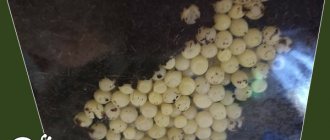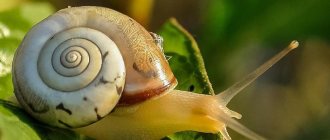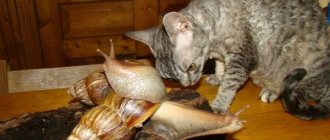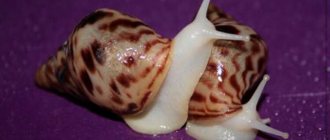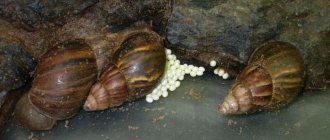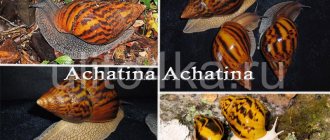In East Africa, Achatina snails are serious pests that threaten crops because they readily feed on sugar cane. They are too cold to live in the natural conditions of Russia, but Achatina are often kept as pets. From the article you will learn about how Achatina snails reproduce and how to grow them under normal conditions at home. When favorable conditions are created, these mollusks grow and reproduce very quickly. The owner just needs to create a comfortable environment.
How do Achatina snails reproduce?
Sexual maturity in African snails occurs at six months of age. Like most mollusks, they are hermaphrodites, but require a partner. To obtain the first offspring, two individuals are enough. The advantage of the double structure of the reproductive system is that there is no need to track which sex of the snail is in the pair. When they reach reproductive age, they will adjust themselves.
A few facts about Achatina reproduction:
- Usually, larger and stronger individuals act as females;
- After pregnancy, the snail will feel unwell and stop growing;
- Young mother snails may have problems with their shell due to a lack of calcium;
- If you decide to breed Achatina snails at home , be prepared for an increase in pets of 100 or more individuals, they grow quickly and require a lot of food.
Owners who want to have a giant African clam in an aquarium are not recommended to let them breed. Pregnancy and egg laying deplete the body, causing the snail to stop growing.
Conditions for reproduction
To observe how Achatina snails reproduce at home , you need to comply with 3 parameters:
- Calcium supplement. It is needed to replenish its own snail reserves, which are spent on the formation of the shells of offspring.
- Suitable soil. Mollusks prefer to sleep and lay offspring in secluded places. Fine stone chips and coconut substrate are suitable. The thickness of the substrate is 10 cm or more.
- Warm. It is necessary to constantly maintain a temperature of 27-28 degrees so that pets find conditions favorable for reproduction.
During this period, future parents should not be disturbed by moving, temperature changes, or lack of food.
How to select snails
We need healthy individuals that have grown to the stage when the active increase in size and shell is inhibited.
It is better not to mate snails from the same clutch, close relatives. After several generations, this can provoke mutations.
How often do Achatina snails reproduce?
Technically, the breeding season can occur every 1.5 months. This is the period from mating to full readiness for the birth of babies. Immediately after laying, the female will be able to become pregnant again, but often reproduction will have a very bad effect on her health.
Self-fertilization
Snails are hermaphrodites, so there may be cases when a snail lays eggs while living alone. From such a clutch, offspring can hatch, since a double set of genes is present in all individuals.
Most often, self-fertilization occurs in Achatina immaculata. They don’t need a couple to prolong the race. Upon reaching five to six months, the snail can lay eggs. This happens less often in fulicas and reticulata; they prefer to reproduce in pairs.
How do Achatina snails mate?
For several days before mating, individuals look closely at each other and resort to simple courtship. If the female has grown to a large size, the male can sit inside her shell for a long time.
The mating process itself takes 2-4 hours. The male fertilizes his partner through the head cavity, protruding his genitals. They connect by sitting close to each other or the male crawls onto the female's shell.
The reproductive system of Achatina is very fragile. If they are disturbed or separated during mating, the genitals may be permanently damaged. Reproduction of such snails is impossible.
Pregnancy and laying
Pregnancy in Achatina occurs after mating and lasts 2-3 weeks. Before laying eggs, the snail may become lethargic, refuse to eat, and bury itself in the ground. If you pick it up, you can feel that the weight has increased significantly, and sometimes there are eggs in the spiracle. But there may also be surprises when, without any signs, the snail suddenly lays eggs.
It is not necessary to separate a pregnant snail from others or change the conditions in any way; this will only create unnecessary stress. After laying, it must be provided with a sufficient amount of calcium to restore the reserves spent on the shell.
On average, an Achatina clutch contains 100-300 eggs. But there are also small ones, in which there are only 10-20. Such clutches are mistakenly called “trial” in the belief that nothing will hatch from them. But that's not true. If there is a clutch, then it is definitely fertilized. The eggs are oval-shaped, white or yellowish, covered with a hard shell, like chicken eggs. When the embryo develops, it begins to absorb the contents of the egg from the inside, and then gnaws through the shell. Hatching may take several days, but you should not help the snails and break the egg, as this can damage the delicate shell.
How to care for Achatina eggs
Some tips on how to care for African snail eggs:
- You need to let the female lay the entire clutch, only after that you can take the eggs;
- It is better to take all the balls from the terrarium and sort them out;
- Eggs with viable offspring are pure white, not blue, not yellow;
- It is better to choose 10-12 eggs from the entire clutch, the largest and neatest;
- The new clutch is placed in a separate terrarium with soft moss;
- The recommended temperature for ripening caviar is 20-22 degrees;
- Sometimes you need to carefully sort out the filler, moving the eggs.
The hatched individuals are placed in a common terrarium.
Rejected eggs can be processed into food for shellfish; cannibalism is the norm for them.
Reasons for the absence of offspring
It happens that all the conditions for reproduction are met, the terrarium is prepared, the snail is full of strength and ready for pregnancy, but there are no offspring . In this case, check the following nuances :
- Receiving individuals complete and balanced nutrition. The presence of additional feeding.
- One of the reasons may be the small thickness of the soil, for example, only 5 cm. In this case, the snail has nowhere to lay its eggs.
- Purity of the earth. If the soil is contaminated, Achatina will not be able to reproduce in it.
In addition, it is important to think about where to distribute future offspring. You cannot breed snails without a specific purpose. Experts advise deciding in advance why breeding is being done. Many people do this for sale or as a gift to friends and relatives.
How do Achatina grow?
Kids do not need special conditions or a separate terrarium. Immediately after hatching, they can be placed with their parents.
Individuals are friendly to each other and will not show aggression or try to eat their offspring.
They need to be separated after six months, when the new generation is ready to reproduce. To prevent sexually mature mollusks from reproducing, they will need to be separated.
Reproduction of Achatina at home
African Achatina (regardless of the species: achatina iredalei, achatina reticulata, achatina fulica, etc.) are hermaphrodites, that is, they combine both male and female principles, but they need a pair to reproduce. Self-fertilization rarely occurs, so there is no need to worry that a lonely Achatina will suddenly begin to give birth. The larger and more resilient individual becomes the female in a pair of future parents, because pregnancy is a complex process that takes a lot of effort from the mollusk. However, there may be cases when both Achatina from a pair brought offspring at once.
In the Achatina snail, reproduction is possible from 6–8 months of life, however, snail experts recommend mating only those mollusks that have reached one year, since up to this point the pet is growing and developing. The genital organ is located on the neck and looks like a tubercle or depression of a light cream color. Its appearance signals that the pet is ready to reproduce.
How to care for little Achatina
Very tiny snails can be planted in an aquarium with lettuce or cabbage leaves and fed with mineral powder. Such conditions will help babies quickly gain the necessary nutrients and calcium, which has a positive effect on their growth rate.
Otherwise, care comes down to caring for the young snails until they get stronger and become independent. It is important to take care of their life during reproduction and puberty.
Pregnancy will exhaust the body of females. If you don't want to lose a few individuals, don't let them mate often.
Keeping small snails
Snails hatched from eggs are in no hurry to leave the nest and remain for some period in the substrate. They begin to emerge after a few days in small groups.
The shell that remains after hatching is almost completely eaten by the kids , which facilitates the process of cleaning the terrarium.
How deep the masonry was and how dense the substrate is depends on how soon it will be possible to observe the life activity of young Achatina.
Small snails do not require any separate feeding or care. The same applies to them as for adults. The main thing is to provide them with constant access to food so that development and growth are active.
How to feed Achatina
Adult snails prefer plant foods; it forms the basis of their diet:
- Lettuce leaves of any variety;
- Sweet fruits and berries;
- Peas, corn on the cob;
- Tomatoes, carrots, zucchini;
- Spinach, cabbage;
- Cucumbers.
All products are offered to shellfish in fresh condition. Some representatives of the species are capricious in food, especially in favorable living conditions. Owners will have to observe which treats their pets like best.
What does Achatina eat?
Achatina are not whimsical in their diet; they eat absolutely everything (which is why they are considered pests in some places in their homeland). The main rule is to give only fresh food, be it greens or dry bulk products. If the leaves of the plants that were offered to the snails as food dry out or begin to rot slightly, this needs to be removed for young Achatina, but for adults it will be used as food.
Under no circumstances should you give lost or sour food, and pasta is simply dangerous for snails. To make it easier to keep the terrarium clean, it is more convenient to feed the snails not from the ground, but to place the food in special flat feeders. It is advisable that the water also be in a flat, not deep container. This will allow the snail not only to drink, but also to bathe safely. Despite the fact that Achatina is a land snail, it really likes to swim. It is advisable to bathe the snail under running water once a day in the evening. Or periodically irrigate the entire terrarium with a spray bottle. But at the same time, water should not be allowed to collect at the bottom of the terrarium under the ground, otherwise a “swamp” with an unpleasant odor will eventually form, unsuitable for the snail to live in.
It is very important to give snails sepia, chalk, and ground eggshells. All this is required for the “construction” of a growing shell. And it grows throughout the life of the snail, which can last an average of 5 years.
Mating and fertilization
Before mating, partners arrange mating dances, which can last from 2 to 14 hours. They are accompanied by contact of the genital organs located closer to the head.
The larger individual acts as a female, as it is physically more resilient. This means it is more adapted to bearing offspring.
Read more about how snails mate and watch here.
Appearance
In nature, the mollusk can grow up to 30 cm long, and the maximum weight reaches 500 grams. Homemade Achatina can grow throughout its life.
The shell is conical, the curls usually go counterclockwise, and occasionally they are reverse curled. In adult individuals, the shell is 5-10 cm long, although the shell of some representatives of the species is up to 20-25 cm. In older Achatina, the shell has 7-9 coils.
There are 4 tentacles on the head with eyes at the tips. With them, the snail senses the level of illumination and looks at the closest objects (at a distance of a centimeter).
The mollusk senses odors with the tips of its horns and the skin of the head end of its body, and determines the outlines of obstacles with its sole. The snail breathes through its skin.
The huge shell of Achatina is decorated with a bizarre pattern, which is directly related to the environment in which the snail lived and what it ate throughout its life. Usually you can see stripes of reddish-brown and yellowish tints on it.
Diseases and their prevention
To prevent various diseases, it is necessary to eliminate the causes of their occurrence. All of them are associated with improper care of pets and their homes. Among the main ones are the following:
- sudden temperature changes, severe hypothermia or overheating;
- use of dry or marshy soil;
- insufficient amount of free space;
- poor quality nutrition;
- lack of protein or calcium;
- rare cleaning of the terrarium;
- poor ventilation.
Identifying a sick individual is quite simple. To do this, just take a closer look at it and observe it throughout the day. An unhealthy snail will move little, refuse food, and block the entrance to the shell. In addition, visible changes in the shell, such as delamination and the appearance of defects, may appear.
To minimize the harm caused to the health of the mollusk, it is necessary to begin treatment as quickly as possible. To do this, you need to create ideal environmental conditions for the snail and add a large amount of vitamins and calcium to the food.
The Achatina snail is a wonderful creature that is a pleasure to watch and care for. If you follow all the rules and follow the recommendations of professionals, you can get rid of any health problems and maximize your pet’s life expectancy. For this he will thank the owner with his active behavior and attractive appearance.
